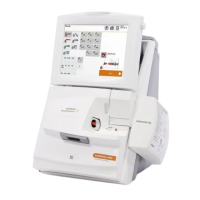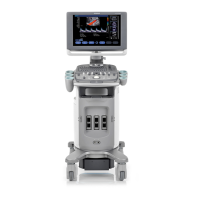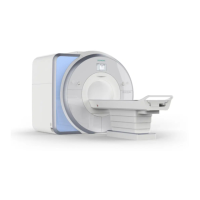1-38 Rapidlab 1200 Operator’s Guide: System Overview and Intended Use
02087462 Rev. V
Oxygen Tension (pO
2
)
Oxygen (O
2
) is essential for cell and tissue metabolism in the body. The cardiopulmonary
system is responsible for transporting oxygen to the cells. Oxygen transport involves 4
major steps: convection and diffusion from the air into the pulmonary circulation,
combination of O
2
from the lungs with hemoglobin in red blood cells, transportation of the
O
2
through the arteries to the cell, and finally the release into the tissues and utilization of
O
2
at the cellular level.
Because it is not possible to measure intra-cellular oxygen tension (pO
2
), arterial pO
2
has
become a standard for clinical evaluation of arterial oxygenation status. Measurement of
pO
2
(A), which indicates the oxygen tension in arterial blood, reflects the pressure or
driving force for moving oxygen from 1 location to the next due to pressure differential; it
is not a measurement of the O
2
content, but it provides a measurement tool to evaluate the
pulmonary gas exchange efficiency from an arterial blood sample.
Complete laboratory evaluation of oxygenation often requires much more than simple
blood gas measurements. Assessment of ventilatory system and acid-base status is
essential to properly interpret clinical significance of arterial oxygenation status. However,
many patients can be evaluated and treated successfully using blood gases alone if clinical
observations and patient history are taken into account.
9
This analyte reflects the ability of the lungs to deliver oxygen to the blood. Hypoxia (low
pO
2
) may occur despite adequate respiration due to parenchymal lung diseases
(pneumonia, asthma, pulmonary edema, and pulmonary fibrosis) due to pulmonary
shunting of blood. Extremely low pO
2
is a potentially life-threatening pathophysiologic
state that must be corrected promptly.
6,7
The measurement of pO
2
is significant in evaluating the degree of hypoxemia (a
deficiency of O
2
in arterial blood) present in a patient. The laboratory reference value for
pO
2
is usually 95 mmHg (12.7 kPa) for a healthy young adult living near sea level.
However, as with pCO
2
and pH, a wider range of values may occur before any therapeutic
action is indicated. Generally a pO
2
of 80 mmHg (10.7 kPa) signals therapeutically
significant hypoxemia. Above this value is very little change in oxygen saturation or
oxygen content with changes in oxygen tension, but below this value changes in saturation
can occur rapidly. Exceptions to this limit are newborns, who have an acceptable range of
40
to 70 mmHg (5.3 to 9.3 kPa) and adults over 50 years old, who have a normal
deterioration of lung function that causes a decrease in expected pO
2
values of about
1 mmHg (0.13 kPa) per year.
10

